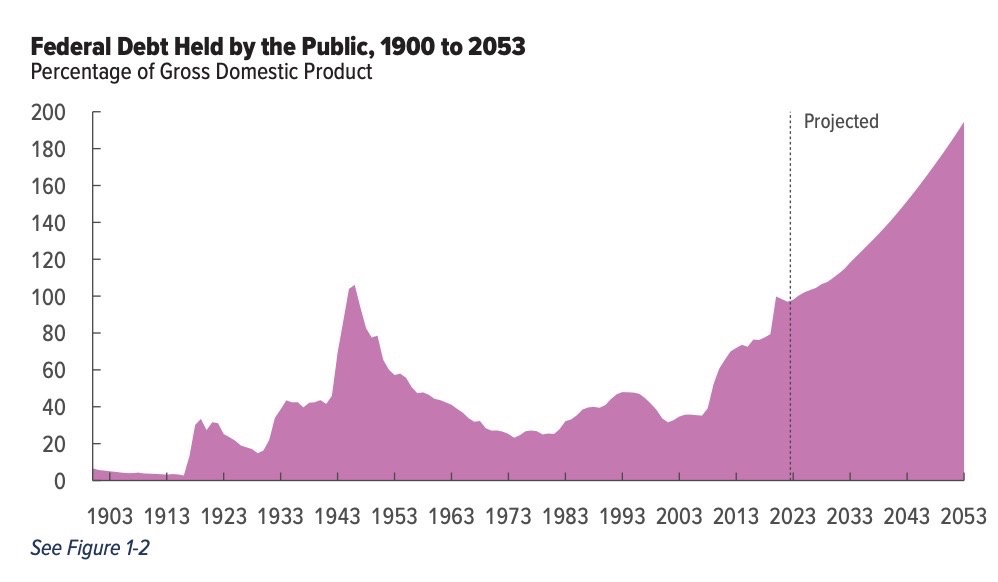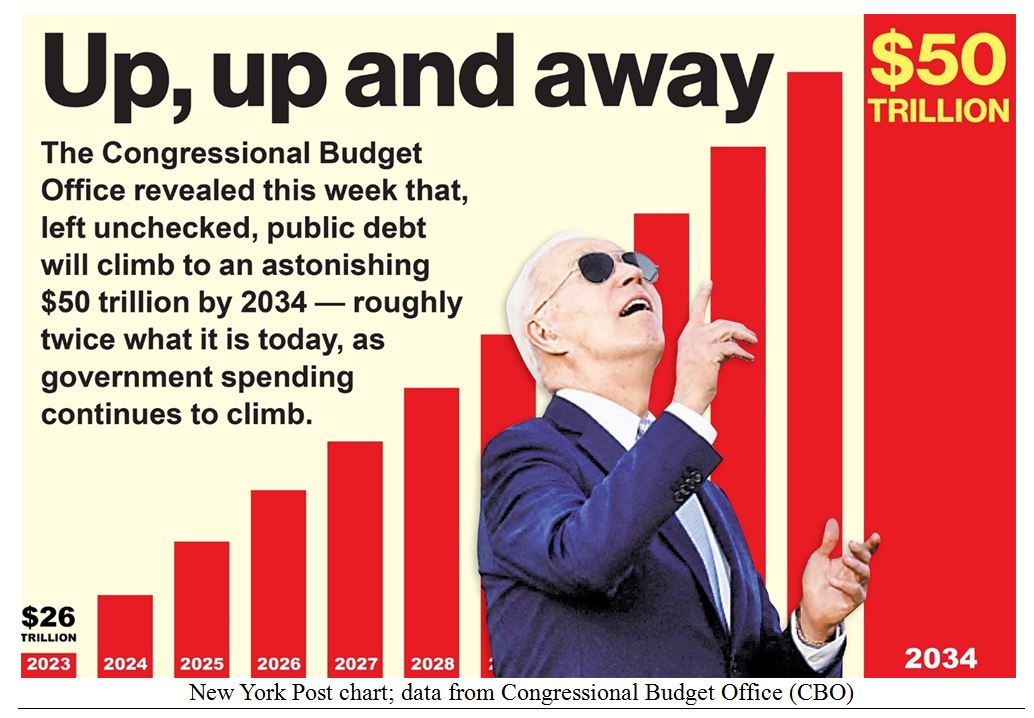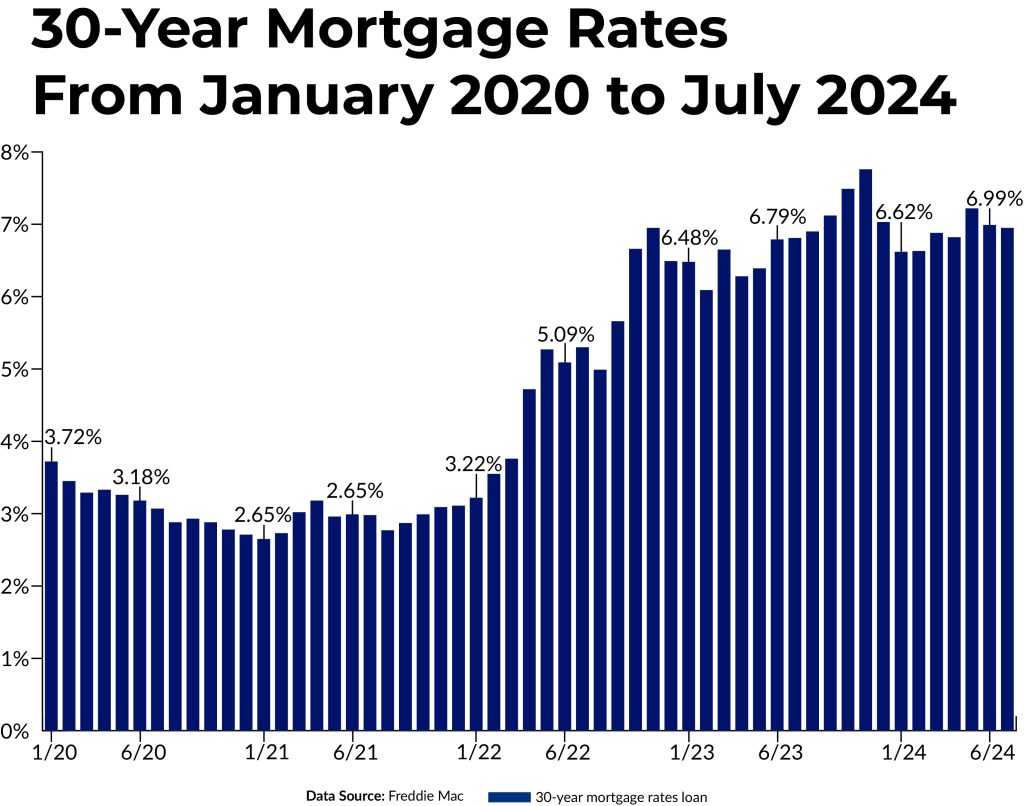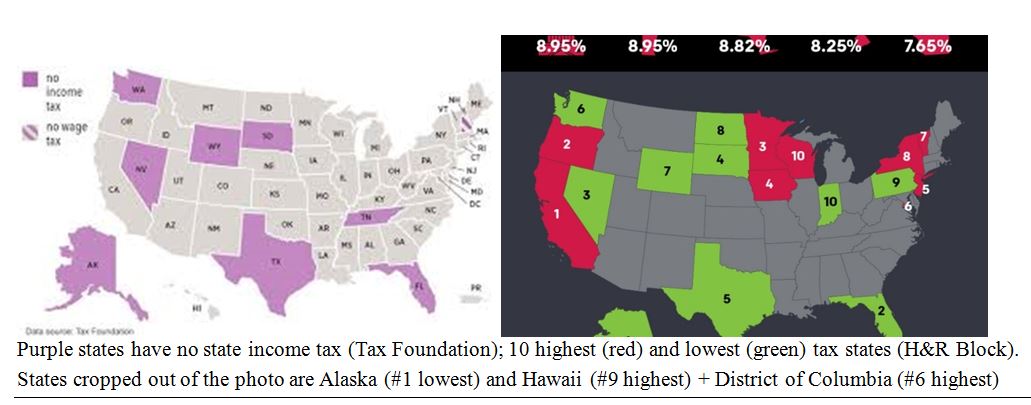by Gary Alexander
September 17, 2024
Happy Constitution Day! Never heard of it? That’s because it was renamed Citizenship Day in 1952 and faded quickly, but on September 17, 1787, the Constitution was signed by 38 of the 41 delegates present at the Constitutional Convention in Philadelphia. A miraculous document and nation were born.
For over 125 years, this great nation survived without an income tax, until the 16th Amendment passed in 1913, and yesterday marked the IRS’s quarterly tax due date for those of us who are self-employed. Sadly, the imposition of income taxes and the Federal Reserve in 1913 in no way helped to balance our budgets:

![]()
Graphs are for illustrative and discussion purposes only. Please read important disclosures at the end of this commentary.
This brings us to the widely heralded Presidential debate last Tuesday, September 10. Earlier that day, the Congressional Budget Office (CBO) revealed that in August, the month Kamala Harris inherited the Democratic Party nomination, the Biden-Harris administration ran up a deficit of $381 billion, on the road to its second straight $2 trillion deficit (Fiscal Year 2024 ends September 30). The CBO says the deficit for the first 11 months of FY’24 is 11% higher than in FY’23. There is no problem with tax receipts, as income tax receipts are also up 11%, and corporate income tax receipts are up 29%, thanks to the lower top tax rates after the 2017 tax law, luring more corporations to repatriate their income back to America.
The problem is spending. Tax receipts totaled $4.4 trillion, but outlays are $6.3 trillion. Medicare spending is up 10%. Net interest on the public debt is up 35%, to $870 billion, more than all military spending, at $753 billion. Yet candidate Harris has three new programs of $50k, $25k and $6k per family ($81,000 total) to engorge the deficit in 2025 and beyond, hoping to pay for those plans with $5 trillion in new taxes in the next 10 years – the sorts of taxes that history has proven will chase income into hiding.

You would think that with this monstrous spilling of red ink that the journalists at ABC News would ask at least one question like, “What 2 or 3 things would you do to close the massive budget deficit gap?”
No such luck. In checking the transcript of the 90-minute debate, there is no question about debts or deficits, no mention of the word “growth” or “spending” or “government waste” (or Elon Musk) or “wealth tax” or “capital gains” or “price controls.” The hosts never once held the candidates’ feet to the fire over their multiple new grandiose spending plans or promises for massive new tax exemptions.
For instance, former President Donald Trump first promised no taxes on tips, then he upped the ante to no taxes on Social Security benefits, and last Thursday in a Tucson rally, he said there would be no taxes on overtime pay. Wow! Some 42% of all workers log 45 or more hours per week, but if Mr. Trump’s latest promise passes into law, you would quickly see 75% or more of workers managing to occupy a desk 50 or more hours a week in order to collect that 50% bonus pay with no taxes – with the 41st hour worth double the 40th hour, after taxes, even if it meant stretching the first 40 hours into slow-motion make-work.
Kamala Harris also announced an array of new spending plans announced in last week’s debate as: “(1) I intend on extending a child tax credit for families of $6,000, which is the largest child tax credit that we have given in a long time, so that those young families can afford to buy a crib, buy a car seat, buy clothes for their children; (2) A $50,000 tax deduction to start-up small businesses, knowing they are part of the backbone of America’s economy; (3) Help with a down payment of $25,000 for first-time home buyers.”
Real estate agents will love that third item, but they will privately tell you that a housing subsidy in a hot and rising market is inflationary. The $25,000 subsidy – in money the Treasury does not have – would only cause home-builders or homeowners to raise prices by $25,000. Home prices are already up 26% and rent costs are up 47% since 2000, but the rising cost of mortgages have forced the monthly debt service cost of owning a home to nearly double the 2019 levels. That’s where the real solution lies: Lower rates.

Graphs are for illustrative and discussion purposes only. Please read important disclosures at the end of this commentary.
The total solution, as I mentioned earlier, is to increase the housing supply and lower mortgage interest rates. She must also reduce or eliminate the punitive regulatory barriers to construction of new homes.
Taxes STILL Have Consequences: Ask California, Florida, New York or Texas
As I mentioned two weeks ago, Ludwig von Mises wrote a massive economics classic, “Human Action,” in 1949, focusing on what he called “Praxeology,” human practices, our subjective response to changing facts and situations. When governments punish your hard work too much, you tend to cut back on work or find legal ways to shelter or delay payment of higher tax rates. You choose more leisure, if you can. When governments let you keep more of what you earn, you tend to work harder and earn as much as you can.

The same is true of states with high tax rates and low tax rates. People are leaving one to enter the other. Millions of Americans are voting with their U-Hauls. The top five states, net in and out, 2020-23, are:

These are American citizens moving between states, not newly arrived immigrants. The trend for young professionals is similar. Using IRS data, SmartAsset looked at where young, highly paid professionals (aged 26 to 35 and earning $200,000 or more) moved in tax-year 2022. The biggest losing state, by far, was California (-3,226), followed by Illinois (-1,323), Massachusetts (-1,102) and New York (-345), all high-tax blue states, overlapping the national totals cited above. The biggest gainers were also a match for the national totals: Florida (+1,786) and Texas (+1,660). The first list consists of very-high tax states, while Florida and Texas have no state income tax. Other big (top 10) gainers with no state income taxes were Washington (+383), Tennessee (+347) and Nevada (+162). State tax policies have consequences.

Graphs are for illustrative and discussion purposes only. Please read important disclosures at the end of this commentary.
California is the biggest loser because they punish taxpayers the most. According to The Wall Street Journal (“The High Tax State Brain Drain,” September 9, 2024), “the average adjusted gross income for California households in the ‘young and rich’ demographic is $480,776. These folks pay a top marginal tax rate of at least 9.3%, and those making more than $1 million pay 13.3%,” on top of federal tax rates.
And now comes Ms. Harris’s ultimate nuclear option, taxing “unrealized capital gains” as the inevitable outcome of her “billionaire’s minimum tax,” deceptively aimed at those worth one tenth of a billion ($100 million or more), so 99.99% of voters will say, “That’s not me, so go ahead and soak the rich.” However, dear friends, you will be soaked very wet in the process. For the rich to sell 25% of the theoretical value of their paper assets (each year!) requires selling those assets at “fire sale” (forced sale) prices, depressing the entire market, including your 401(k), IRA and other savings. Stocks would enter a tailspin, plunging the economy into a deep recession, with millions of job layoffs and a soaring deficit to fund big bailouts.
No matter whom you select as President, at least elect a responsible Congress to keep this madness at bay.
All content above represents the opinion of Gary Alexander of Navellier & Associates, Inc.
Also In This Issue
A Look Ahead by Louis Navellier
We Barely Dodged World War III (Again) Last Week
Income Mail by Bryan Perry
The Rally That Nobody Saw Coming
Growth Mail by Gary Alexander
Debaters Dodge Deficits (and Growth, and Lots More)
Global Mail by Ivan Martchev
A Fresh All-Time High in the S&P 500 Likely This Week
Sector Spotlight by Jason Bodner
September 18th Creates a Turning Point for Stocks
View Full Archive
Read Past Issues Here
About The Author

Gary Alexander
SENIOR EDITOR
Gary Alexander has been Senior Writer at Navellier since 2009. He edits Navellier’s weekly Marketmail and writes a weekly Growth Mail column, in which he uses market history to support the case for growth stocks. For the previous 20-years before joining Navellier, he was Senior Executive Editor at InvestorPlace Media (formerly Phillips Publishing), where he worked with several leading investment analysts, including Louis Navellier (since 1997), helping launch Louis Navellier’s Blue Chip Growth and Global Growth newsletters.
Prior to that, Gary edited Wealth Magazine and Gold Newsletter and wrote various investment research reports for Jefferson Financial in New Orleans in the 1980s. He began his financial newsletter career with KCI Communications in 1980, where he served as consulting editor for Personal Finance newsletter while serving as general manager of KCI’s Alexandria House book division. Before that, he covered the economics beat for news magazines. All content of “Growth Mail” represents the opinion of Gary Alexander
Important Disclosures:
Although information in these reports has been obtained from and is based upon sources that Navellier believes to be reliable, Navellier does not guarantee its accuracy and it may be incomplete or condensed. All opinions and estimates constitute Navellier’s judgment as of the date the report was created and are subject to change without notice. These reports are for informational purposes only and are not a solicitation for the purchase or sale of a security. Any decision to purchase securities mentioned in these reports must take into account existing public information on such securities or any registered prospectus.To the extent permitted by law, neither Navellier & Associates, Inc., nor any of its affiliates, agents, or service providers assumes any liability or responsibility nor owes any duty of care for any consequences of any person acting or refraining to act in reliance on the information contained in this communication or for any decision based on it.
Past performance is no indication of future results. Investment in securities involves significant risk and has the potential for partial or complete loss of funds invested. It should not be assumed that any securities recommendations made by Navellier. in the future will be profitable or equal the performance of securities made in this report. Dividend payments are not guaranteed. The amount of a dividend payment, if any, can vary over time and issuers may reduce dividends paid on securities in the event of a recession or adverse event affecting a specific industry or issuer.
None of the stock information, data, and company information presented herein constitutes a recommendation by Navellier or a solicitation to buy or sell any securities. Any specific securities identified and described do not represent all of the securities purchased, sold, or recommended for advisory clients. The holdings identified do not represent all of the securities purchased, sold, or recommended for advisory clients and the reader should not assume that investments in the securities identified and discussed were or will be profitable.
Information presented is general information that does not take into account your individual circumstances, financial situation, or needs, nor does it present a personalized recommendation to you. Individual stocks presented may not be suitable for every investor. Investment in securities involves significant risk and has the potential for partial or complete loss of funds invested. Investment in fixed income securities has the potential for the investment return and principal value of an investment to fluctuate so that an investor’s holdings, when redeemed, may be worth less than their original cost.
One cannot invest directly in an index. Index is unmanaged and index performance does not reflect deduction of fees, expenses, or taxes. Presentation of Index data does not reflect a belief by Navellier that any stock index constitutes an investment alternative to any Navellier equity strategy or is necessarily comparable to such strategies. Among the most important differences between the Indices and Navellier strategies are that the Navellier equity strategies may (1) incur material management fees, (2) concentrate its investments in relatively few stocks, industries, or sectors, (3) have significantly greater trading activity and related costs, and (4) be significantly more or less volatile than the Indices.
ETF Risk: We may invest in exchange traded funds (“ETFs”) and some of our investment strategies are generally fully invested in ETFs. Like traditional mutual funds, ETFs charge asset-based fees, but they generally do not charge initial sales charges or redemption fees and investors typically pay only customary brokerage fees to buy and sell ETF shares. The fees and costs charged by ETFs held in client accounts will not be deducted from the compensation the client pays Navellier. ETF prices can fluctuate up or down, and a client account could lose money investing in an ETF if the prices of the securities owned by the ETF go down. ETFs are subject to additional risks:
- ETF shares may trade above or below their net asset value;
- An active trading market for an ETF’s shares may not develop or be maintained;
- The value of an ETF may be more volatile than the underlying portfolio of securities the ETF is designed to track;
- The cost of owning shares of the ETF may exceed those a client would incur by directly investing in the underlying securities; and
- Trading of an ETF’s shares may be halted if the listing exchange’s officials deem it appropriate, the shares are delisted from the exchange, or the activation of market-wide “circuit breakers” (which are tied to large decreases in stock prices) halts stock trading generally.
Grader Disclosures: Investment in equity strategies involves substantial risk and has the potential for partial or complete loss of funds invested. The sample portfolio and any accompanying charts are for informational purposes only and are not to be construed as a solicitation to buy or sell any financial instrument and should not be relied upon as the sole factor in an investment making decision. As a matter of normal and important disclosures to you, as a potential investor, please consider the following: The performance presented is not based on any actual securities trading, portfolio, or accounts, and the reported performance of the A, B, C, D, and F portfolios (collectively the “model portfolios”) should be considered mere “paper” or pro forma performance results based on Navellier’s research.
Investors evaluating any of Navellier & Associates, Inc.’s, (or its affiliates’) Investment Products must not use any information presented here, including the performance figures of the model portfolios, in their evaluation of any Navellier Investment Products. Navellier Investment Products include the firm’s mutual funds and managed accounts. The model portfolios, charts, and other information presented do not represent actual funded trades and are not actual funded portfolios. There are material differences between Navellier Investment Products’ portfolios and the model portfolios, research, and performance figures presented here. The model portfolios and the research results (1) may contain stocks or ETFs that are illiquid and difficult to trade; (2) may contain stock or ETF holdings materially different from actual funded Navellier Investment Product portfolios; (3) include the reinvestment of all dividends and other earnings, estimated trading costs, commissions, or management fees; and, (4) may not reflect prices obtained in an actual funded Navellier Investment Product portfolio. For these and other reasons, the reported performances of model portfolios do not reflect the performance results of Navellier’s actually funded and traded Investment Products. In most cases, Navellier’s Investment Products have materially lower performance results than the performances of the model portfolios presented.
This report contains statements that are, or may be considered to be, forward-looking statements. All statements that are not historical facts, including statements about our beliefs or expectations, are “forward-looking statements” within the meaning of The U.S. Private Securities Litigation Reform Act of 1995. These statements may be identified by such forward-looking terminology as “expect,” “estimate,” “plan,” “intend,” “believe,” “anticipate,” “may,” “will,” “should,” “could,” “continue,” “project,” or similar statements or variations of such terms. Our forward-looking statements are based on a series of expectations, assumptions, and projections, are not guarantees of future results or performance, and involve substantial risks and uncertainty as described in Form ADV Part 2A of our filing with the Securities and Exchange Commission (SEC), which is available at www.adviserinfo.sec.gov or by requesting a copy by emailing info@navellier.com. All of our forward-looking statements are as of the date of this report only. We can give no assurance that such expectations or forward-looking statements will prove to be correct. Actual results may differ materially. You are urged to carefully consider all such factors.
FEDERAL TAX ADVICE DISCLAIMER: As required by U.S. Treasury Regulations, you are informed that, to the extent this presentation includes any federal tax advice, the presentation is not written by Navellier to be used, and cannot be used, for the purpose of avoiding federal tax penalties. Navellier does not advise on any income tax requirements or issues. Use of any information presented by Navellier is for general information only and does not represent tax advice either express or implied. You are encouraged to seek professional tax advice for income tax questions and assistance.
IMPORTANT NEWSLETTER DISCLOSURE:The hypothetical performance results for investment newsletters that are authored or edited by Louis Navellier, including Louis Navellier’s Growth Investor, Louis Navellier’s Breakthrough Stocks, Louis Navellier’s Accelerated Profits, and Louis Navellier’s Platinum Club, are not based on any actual securities trading, portfolio, or accounts, and the newsletters’ reported hypothetical performances should be considered mere “paper” or proforma hypothetical performance results and are not actual performance of real world trades. Navellier & Associates, Inc. does not have any relation to or affiliation with the owner of these newsletters. There are material differences between Navellier Investment Products’ portfolios and the InvestorPlace Media, LLC newsletter portfolios authored by Louis Navellier. The InvestorPlace Media, LLC newsletters contain hypothetical performance that do not include transaction costs, advisory fees, or other fees a client might incur if actual investments and trades were being made by an investor. As a result, newsletter performance should not be used to evaluate Navellier Investment services which are separate and different from the newsletters. The owner of the newsletters is InvestorPlace Media, LLC and any questions concerning the newsletters, including any newsletter advertising or hypothetical Newsletter performance claims, (which are calculated solely by Investor Place Media and not Navellier) should be referred to InvestorPlace Media, LLC at (800) 718-8289.
Please note that Navellier & Associates and the Navellier Private Client Group are managed completely independent of the newsletters owned and published by InvestorPlace Media, LLC and written and edited by Louis Navellier, and investment performance of the newsletters should in no way be considered indicative of potential future investment performance for any Navellier & Associates separately managed account portfolio. Potential investors should consult with their financial advisor before investing in any Navellier Investment Product.
Navellier claims compliance with Global Investment Performance Standards (GIPS). To receive a complete list and descriptions of Navellier’s composites and/or a presentation that adheres to the GIPS standards, please contact Navellier or click here. It should not be assumed that any securities recommendations made by Navellier & Associates, Inc. in the future will be profitable or equal the performance of securities made in this report.
FactSet Disclosure: Navellier does not independently calculate the statistical information included in the attached report. The calculation and the information are provided by FactSet, a company not related to Navellier. Although information contained in the report has been obtained from FactSet and is based on sources Navellier believes to be reliable, Navellier does not guarantee its accuracy, and it may be incomplete or condensed. The report and the related FactSet sourced information are provided on an “as is” basis. The user assumes the entire risk of any use made of this information. Investors should consider the report as only a single factor in making their investment decision. The report is for informational purposes only and is not intended as an offer or solicitation for the purchase or sale of a security. FactSet sourced information is the exclusive property of FactSet. Without prior written permission of FactSet, this information may not be reproduced, disseminated or used to create any financial products. All indices are unmanaged and performance of the indices include reinvestment of dividends and interest income, unless otherwise noted, are not illustrative of any particular investment and an investment cannot be made in any index. Past performance is no guarantee of future results.
